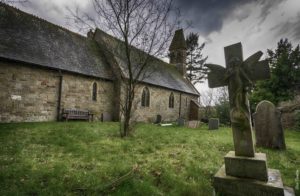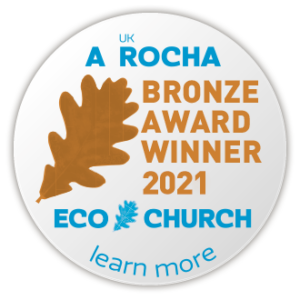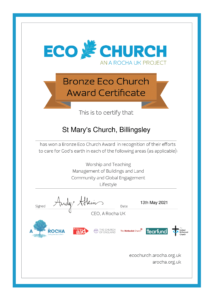In Spring 2021 St Mary’s Church was awarded a bronze Eco Church award as part of a Rocha UK project. St Mary’s is the first church in the Severn Valley benefice to receive an award. More details of the scheme can be found on their website https://ecochurch.arocha.org.uk/how-eco-church-works/
As a member of this scheme St Mary’s completed an Eco Survey which covered different areas of how the church contributes to God’s earth in different areas of its life and work. The answers provided gained points towards an Eco Church Award – the more any church does, the more points they get! St Mary’s is now looking to build upon the progress already made to gain a silver award.
The survey covers five key areas of church life:
- Worship and teaching
- Management of church buildings
- Management of church land
- Community and global engagement
- Lifestyle
Do watch out for more news, events and information over the coming weeks as we make progress.
For information about the work carried out by Caring for God’s Acre click here.
Heaven on Earth –St Mary’s Churchyard, Billingsley
The churchyard at St Mary’s is truly a ‘Heaven on Earth’ in many respects.
The land has never been intensively managed or subject to chemical fertilisers or herbicides which make it a unique and special place. It is managed very specifically to increase biodiversity for flora and fauna and provides niche habitats for many insects, small mammals and birds. Various zones are managed to create different environments; you can find out more by looking at the management plan. At certain times of the year the grounds may appear ‘untidy’ but nature prefers it this way and we are happy to let the wildflowers grow and scatter their own seeds. You will notice that in corners of the churchyard piles of wood have been deliberately left to give shelter and will rot down providing valuable food for decomposers.
The churchyard is a peaceful and tranquil haven that can be enjoyed by humans too. Explore the grounds and see what you can spot. There are many things to look out for such as the ancient yews which are amongst the oldest in the whole county dating back many centuries. During the winter the ground is blanketed by snowdrops, in spring the primroses are a welcome sight amongst other early flowers. By the summer wild flowers grow within the tall grasses and in autumn many very beautiful varieties of fungi appear. The memorable stones provide special habitats to lichens and sloe worms and newts have been spotted. Take a while to sit, stop and listen to the birdsong or just the wind rustling through the trees. Relax and feel at ease and enjoy this very special place that we want to share.
The most recent project was to infill the western hedgerow with native species. We will continue to manage the grounds in an environmentally sensitive way and our future plans include planting bee friendly flower beds with plants especially suited to offering bees the nectar and shelter they need.
St Mary’s Church is fortunate to be supported by Caring for God’s Acre and we are extremely grateful for all their expertise, encouragement, advice and hands on help. Volunteers regularly come along and carry out the hard work of scything, hedge cutting, pruning and many more tasks. Look on our website for details of when they are due to visit as extra hands are always welcome.
St Mary’s Churchyard – A little history
The church was present by 1140 but the use of the churchyard as a sacred space may be much older than that. The two ancient yews could easily be 1000 years old. Yew, as an evergreen and a symbol of rebirth, was regarded as sacred long before Christianity. There also was a well just outside the churchyard, in the lane. Wells, if they are shallow, are also often considered as holy places, communicating with the underworld and may be associated with the ritual deposition of precious objects. A bronze age axe head was found not far from the well. We also know from aerial photographs that there was an iron age or Roman farm close to the church. Thus it is certain people were living close to the churchyard long before the church was built and this spot may long have been considered as special.
There are likely to be several thousand burials in the churchyard. The current graves have been mapped and can be seen on the church website. The oldest is that of the Rev William Lewis Jones from 1844. When work was being done outside the church, two brick vaults were discovered and there are probably more.
The churchyard remains open for burials and is consecrated ground. As you walk or stand in the graveyard, the resting place of the dead of Billingsley for around a millennium, we hope you find your own life is invigorated. This may be from the natural history of this place, its peace and tranquillity or a sense of something beyond you; that some call God. You may want to reflect on the words of Ezekiel, who 2500 years ago, found life by being transported to a place of burial.
The Valley of Dry Bones (Ezekiel 37: 1-14)
The hand of the Lord was on me, and he brought me out by the Spirit of the Lord and set me in the middle of a valley; it was full of bones. He led me back and forth among them, and I saw a great many bones on the floor of the valley, bones that were very dry. He asked me, “Son of man, can these bones live?”
I said, “Sovereign Lord, you alone know.”
Then he said to me, “Prophesy to these bones and say to them, ‘Dry bones, hear the word of the Lord! This is what the Sovereign Lord says to these bones: I will make breath enter you, and you will come to life. I will attach tendons to you and make flesh come upon you and cover you with skin; I will put breath in you, and you will come to life. Then you will know that I am the Lord.’”
So I prophesied as I was commanded. And as I was prophesying, there was a noise, a rattling sound, and the bones came together, bone to bone. I looked, and tendons and flesh appeared on them and skin covered them, but there was no breath in them.
Then he said to me, “Prophesy to the breath; prophesy, son of man, and say to it, ‘This is what the Sovereign Lord says: Come, breath, from the four winds and breathe into these slain, that they may live.’” So I prophesied as he commanded me, and breath entered them; they came to life and stood up on their feet—a vast army.
Then he said to me: “Son of man, these bones are the people of Israel. They say, ‘Our bones are dried up and our hope is gone; we are cut off.’ Therefore prophesy and say to them: ‘This is what the Sovereign Lord says: My people, I am going to open your graves and bring you up from them; I will bring you back to the land of Israel. Then you, my people, will know that I am the Lord, when I open your graves and bring you up from them. I will put my Spirit in you and you will live, and I will settle you in your own land. Then you will know that I the Lord have spoken, and I have done it, declares the Lord.’”


